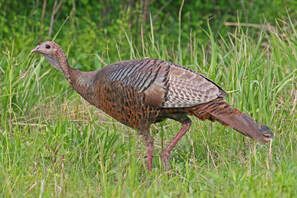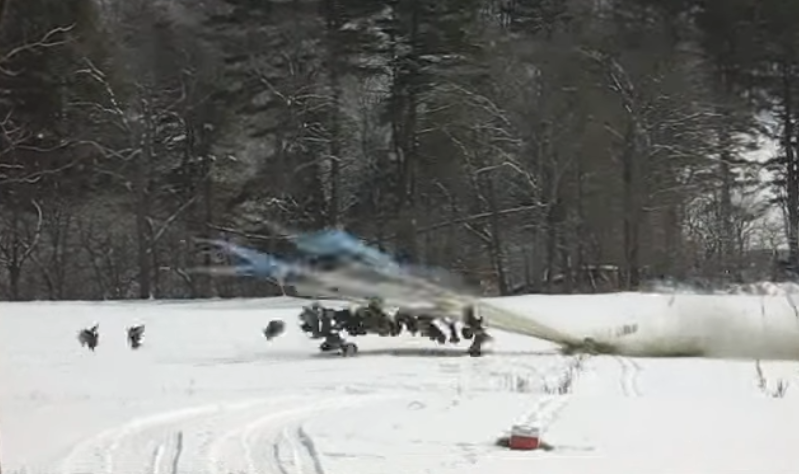 Wikipedia
Wikipedia
History of The Wild Turkey: Turkeys are native to the almost the entire eastern half of the United States, southeastern Canada, and central Mexico, with significant populations in the western U.S. Wild turkeys in North America were aggressively hunted for game in the 19th century and there were fears in the early 20th century that wild turkeys would soon be extinct. As human populations grew in the 1800’s, so did the demands for wild turkey meat. Entirely unregulated subsistence and market hunting were excessive and took their toll on populations. Accounts list single-day harvests that often numbered in the hundreds of birds being hunted and killed. Severe habitat loss during the same period also occurred and magnified the effects of unregulated harvest. The untouched forests were cleared for farmland and urban development and most in the East were gone by 1850, with those in the Atlantic coastal region especially hit hard. Conservation efforts and introduction programs have greatly increased the numbers of wild turkeys, going from only 30,000 in the early 20th century to more than seven million birds today. In the early twentieth century people tried unsuccessfully to use farm turkeys for restoring wild populations, but in the late 1940s they began to successfully transplant wild-caught turkeys into suitable habitat. No other game bird has responded so well to the efforts of game managers. Wildlife biologists continued to experiment with turkey restoration methods throughout the 1950s and 60s, focusing on refining methods for capturing wild birds for relocation efforts. Most of this work was funded by hunter revenues including license fees and excise taxes.
Population Trends: In 1973, the National Wild Turkey Federation (NWTF) was founded with a mission that included the conservation of wild turkeys and the preservation and restoration of suitable wild turkey habitat. Education is also a strong goal of the NWTF, and the organization leads many programs aimed to benefit wild turkeys and promote the appreciation of these unique and fascinating birds. Today, more than 7 million wild turkeys are roaming forested areas of the United States, Canada, and Mexico. Every state in the U.S. except Alaska has a stable enough population to allow regulated hunting of the birds, and turkey hunting is a popular sport. However recently due to a long list of factors the wild turkey population has been on the steady decline in areas across the county. But populations are thriving in urban areas which is causing numerous issues with human wildlife conflict. Much like white tailed deer the wild turkey is suffering from habitat loss and being forced to adapt and live-in backyards, small parks, and even industrial parks.
Legal Status: The birds are popular among hunters; the U.S. Fish and Wildlife Service estimates 21 percent of all U.S. hunters (about 2.5 million people) pursue turkey, making it the second most-sought game after deer. Their expanding populations have made it possible for hunting seasons to be put in place in all 49 states in their range. Just about every state in the lower 48 has a spring and fall turkey season where hunters can harvest these birds with the proper license. Bag limits are set by state agencies that monitor the population and plan accordingly. Spring turkey season typically starts for states in the Southwestern and Southeastern portion of the U.S. in March and early April. This is in relation to the turkeys breading season where male birds are extremely vocal and active. States in the Northeastern part of the country like Ohio, Michigan, New York, Vermont, and Maine typically open their season later due to the breading season starting in late April and early May.
Human -Turkey Conflict: Due to a growing population of turkeys in urban areas of U.S. Cities more and more issues are being documented with human-turkey interactions. Male Turkeys during breading season can be extremely aggressive towards anything or anyone that may come between it and its hen or female turkey ready to bread. There have been numerous videos online of people being chased by turkeys on golf courses and shopping centers, as well as videos of turkeys attacking cars in the road as they back up traffic. The bottom line is the more we continue to develop land we will increase or rate of wildlife interactions.
Management Techniques: Due to urban areas being the largest growth in turkey population as well as documented human interactions, attacks, or nuisance complaints non-Lethal management techniques are typically the best way to deal with unwanted turkeys or aggressive birds that will not budge. Here are some non-lethal techniques that we at Loomacres Wildlife Management use when dealing with Nuisance Turkeys.
Population Trends: In 1973, the National Wild Turkey Federation (NWTF) was founded with a mission that included the conservation of wild turkeys and the preservation and restoration of suitable wild turkey habitat. Education is also a strong goal of the NWTF, and the organization leads many programs aimed to benefit wild turkeys and promote the appreciation of these unique and fascinating birds. Today, more than 7 million wild turkeys are roaming forested areas of the United States, Canada, and Mexico. Every state in the U.S. except Alaska has a stable enough population to allow regulated hunting of the birds, and turkey hunting is a popular sport. However recently due to a long list of factors the wild turkey population has been on the steady decline in areas across the county. But populations are thriving in urban areas which is causing numerous issues with human wildlife conflict. Much like white tailed deer the wild turkey is suffering from habitat loss and being forced to adapt and live-in backyards, small parks, and even industrial parks.
Legal Status: The birds are popular among hunters; the U.S. Fish and Wildlife Service estimates 21 percent of all U.S. hunters (about 2.5 million people) pursue turkey, making it the second most-sought game after deer. Their expanding populations have made it possible for hunting seasons to be put in place in all 49 states in their range. Just about every state in the lower 48 has a spring and fall turkey season where hunters can harvest these birds with the proper license. Bag limits are set by state agencies that monitor the population and plan accordingly. Spring turkey season typically starts for states in the Southwestern and Southeastern portion of the U.S. in March and early April. This is in relation to the turkeys breading season where male birds are extremely vocal and active. States in the Northeastern part of the country like Ohio, Michigan, New York, Vermont, and Maine typically open their season later due to the breading season starting in late April and early May.
Human -Turkey Conflict: Due to a growing population of turkeys in urban areas of U.S. Cities more and more issues are being documented with human-turkey interactions. Male Turkeys during breading season can be extremely aggressive towards anything or anyone that may come between it and its hen or female turkey ready to bread. There have been numerous videos online of people being chased by turkeys on golf courses and shopping centers, as well as videos of turkeys attacking cars in the road as they back up traffic. The bottom line is the more we continue to develop land we will increase or rate of wildlife interactions.
Management Techniques: Due to urban areas being the largest growth in turkey population as well as documented human interactions, attacks, or nuisance complaints non-Lethal management techniques are typically the best way to deal with unwanted turkeys or aggressive birds that will not budge. Here are some non-lethal techniques that we at Loomacres Wildlife Management use when dealing with Nuisance Turkeys.
- Live Trapping & Relocating: Because tradition techniques of trapping were ineffective and caused more harm than good to the turkeys, a Wildlife Biologist invented a cannon net to Trap and Relocate Turkeys. This technique is typically used in the fall or winter months when turkeys tend to travel in large flocks. By using a cannon or rocket propelled net launcher system created to prevent the turkeys from escaping as well as harming themselves, this is a proven technique with incredibly positive results. A net it placed near a bait pile in an area that the flock of turkeys frequent. The thought behind this to lure the flock of turkeys into a targeted area where then the net can be launched safely and successfully capturing as many birds as possible. Once the birds are caught and safely but in transportation crates or boxes, the turkeys are then relocated to prime habitat where they can breed and live wild and free.
- Drone Harassment: Using technology to harass nuisance wildlife is a much growing trend. What we have found is this is a great way to harass nuisance turkeys from a safe distance and is completely harmless. By simply flying a drone in the turkey’s direction or hovering over them they will typically vacate the area in which they are not supposed to be in. This is a great solution for short term success, but it will be a constant battle year after year as new turkeys move into an area. The only downside is sometimes wildlife becomes conditioned to non-lethal methods of harassment.
- Dog Harassment: A new approach using border collies is an effective abatement method that conveys a “real predator” situation for nuisance wildlife. Border collies provide an excellent management technique that incorporates auditory and visual threats to scare nuisance wildlife from an area. Using a well-trained dog to represent a predator in the area is a great tool for any wildlife harassment. Border Collies that we train at Loomacres are trained to mimic coyotes which is a natural predator of turkeys. By introducing a natural predator to an area where nuisance turkeys are living or feeding this method is a sure way to make them disperse quickly and done enough times the pressure of predation is too much for turkeys to stick around for.
- Paint Ball Markers: Another new method introduced recently to non-lethal wildlife harassment is the use of paintball markers or paintball guns. These are strictly used to create a sense of danger and shock factor to the nuisance turkeys. The paint is nontoxic and the speed in which the gun fires is just enough to scare your turkey into not wanting to get hit again. Once your flock gets hit a few times they will typically move on to another property and even if they come back, they will be increasingly skittish and fast to disperse if threatened.
- Effigies: This is an old trick that tends to work short term but can be amazingly effective when coupled with other non-lethal harassment techniques. Simply put a predator effigy in a visible area where you nuisance turkeys have been spotted and let the visual presence of a predator scare them away. We recommend moving the effigy multiple times to prevent your turkeys from becoming conditioned.
- Pyrotechnics: One of the most effective harassment techniques used in any appropriate nuisance wildlife problem is the use of bird bangers. This type of pyrotechnics is used to create a loud noise or aggressive bang scaring the turkeys in an extremely effective and threatening way. We recommend only someone trained and or a professional attempt this technique because it does pose a few safety risks.
